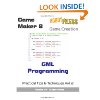GM8 Game Creation Series


GM8 Game Creation GML Programming: Practical Tips & Techniques Vol. 2
GM8 Game Creation: Practical Tips & Techniques Vol. 1, Second Edition
I ended up combining the review for these two books as they are both from HobbyPress and present the same things. At first glance, it looks like something you might see as a photocopied handout used for classroom purposes. The title of these books, "practical tips and techniques" is misleading. Basically, what you get for your money is a glorified troubleshooting Q&A book. Literally, there are no steps showing an end-user tips or techniques for GML programming or Game Creation in Game Maker 8. What you will get are pages upon pages of questions (as the headings), exactly like you would see in a blog where someone is asking for advise, and an answer/explanation below. My suggestion, save your $17.95 (cost on Amazon) and Google troubleshooting blogs on GM8 "GML programming" or "game creation." A Q&A book makes you MANUALLY search for answers, where blogs give you a cool little feature called a "search field" that allows you to easily find the answers to what you are looking for...and it's FREE!Below is a break-down on the books based from standards in graphics design, instructional design, and curriculum writing, as well as comments for classroom teachers, instructors and end-users.
graphics design: It looks like the book was put together using Microsoft Word with a glossy, card stock cover slapped over the pages. Overall look...very unprofessional. Here's why:
- The content font size is overly large;
- there are no distinguishing factors between the headings and body text regarding size or font face, except for the use of the "bold" style;
- there are no distinguishing factors between the heading and body text regarding spacing (everything appears double-spaced);
- lack of the layout principal "proximity," or grouping of related elements, which helps reader form necessary associations for clarify and cognition;
- use of space is poor...page elements (headings, body text and images) are added in a linear fashion instead of positioning them for maximum use of space.
instructional design: There is a lack of structure/organization to these books, however, that is understandable since they are not true instructional guides. It is merely a collection of information on why you do something and a suggestion on how you might go about making something work.
curriculum/content: You might find some useful information in these books, but you will have to search as the visual layout does not give you much help in finding information efficiently or effectively. In addition, with the lack of instructional structure, you will find yourself time and again browsing though long question headings to see if you might find one that will provide you with a solution.
classroom teacher/instructor: As these books do not give any instructional guidance, and you can just as easily use an online forum to troubleshoot issues you might have, these books would not benefit a classroom teacher or instructor.
end-user/learner: As an individual wanting to learn more about these topics, I was extremely disappointed in what they offered. Again, the titles were misleading and I felt "duped" once I opened these books to gain new knowledge. If I was someone who had significant knowledge in these areas, considered myself an expert, and just had a few troubleshooting questions I needed answered, these books might not be so bad to have around. However, it is much easier, more convenient, and more cost effective to just search topics I need help with, or post questions I have to a community blog and get assistance from the people in that community.
Leave a Reply